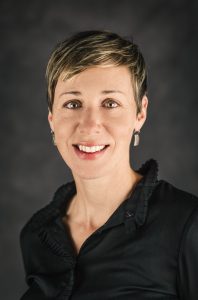Introducing the 2018-2019 C&E Chairperson-Elect

Photo credit: Brittany Bays
The results are in, and Dr. Kirsten Schwarz will assume the chairperson-elect position after #ESA2018.
Meet Kirsten:
We are excited to keep up the Section momentum with Kirsten! She directs the Ecological Stewardship Institute at Northern Kentucky University. She is an urban ecologist who uses a transdisciplinary systems approach to understand how landscape patterns affect ecosystem services in cities. Community engagement, social justice, and equity are central themes of her research. Currently, Kirsten is leading a research team developing green infrastructure designs for vacant lots in partnership with community members, non-profits, city officials and planners in Newport, KY. Kirsten earned her Ph.D. in ecology and evolution from Rutgers University.
Kirsten’s vision for her role with the C&E Section:
Here’s what Kirsten said when she threw her hat in the ring for this position.
Why do you want the job? What is your vision for the Communication & Engagement Section?
I’m an Associate Professor of Environmental Science at Northern Kentucky University working on engaging communities in the process of science, especially science that can facilitate change and address issues of environmental inequity. I am also a 2018-2019 AAAS Leshner Fellow for Public Engagement with Science. In my research and engagement activities, I focus on collaborative interdisciplinary projects through which I have worked with social scientists, policy makers, public health officials, journalists, artists, photographers, dancers, and urban planners. Specific projects include participatory action research on lead contaminated soils and addressing environmental inequities associated with green infrastructure; this work has affirmed the need for effective communication and building strong community relationships. I have developed a service-learning science communication class where students work with community partners to create compelling pieces of science communication using film, photography, and radio in addition to dancing, drawing, and tweeting their science. The resources from the ESA SciComm section were invaluable in developing opportunities for undergraduate STEM students to learn the basics of communication and appreciate their value in society.
Describe who you are and your interests in science communication and engagement.
As an urban ecologist, ESA is my home professional society, but I haven’t always felt at home here. The first time I presented was in 2003 and as a budding urban ecologist I felt isolated and confused as to how my subdiscipline fit into the larger mission of ESA. Since 2003, I’ve noticed tremendous growth at ESA regarding urban ecology and social-ecological systems in general and that’s very exciting. I see a similar trajectory for science communication in the Society. I would love to support the growth, promotion, and valuation of effective science communication in our discipline. My vision for the communication and engagement section is to not only support and advance the incredible work that is being done, but to leverage our communication efforts to promote a more inclusive professional society. We need more people telling the stories of their science. If we can do that, we can demonstrate that science really is for everyone. Being a AAAS Fellow for Public Engagement with Science, this as an incredible opportunity to both advance and share new knowledge with the ESA community regarding effective science communication and engagement.